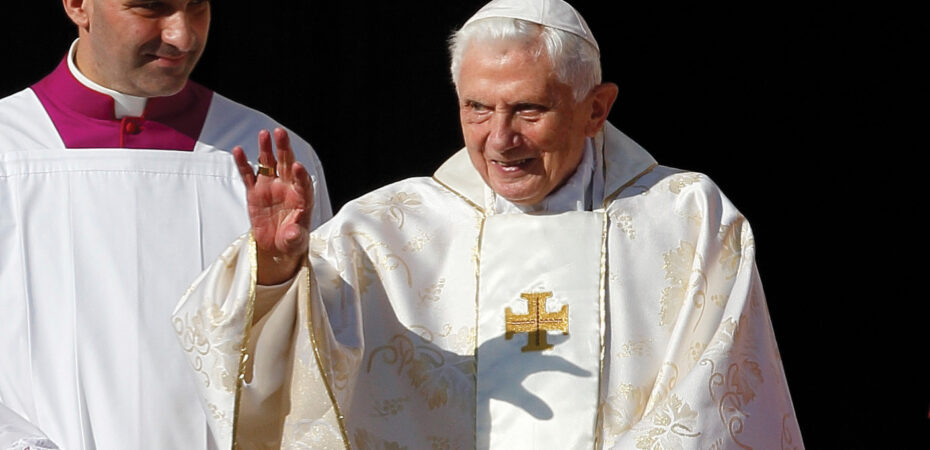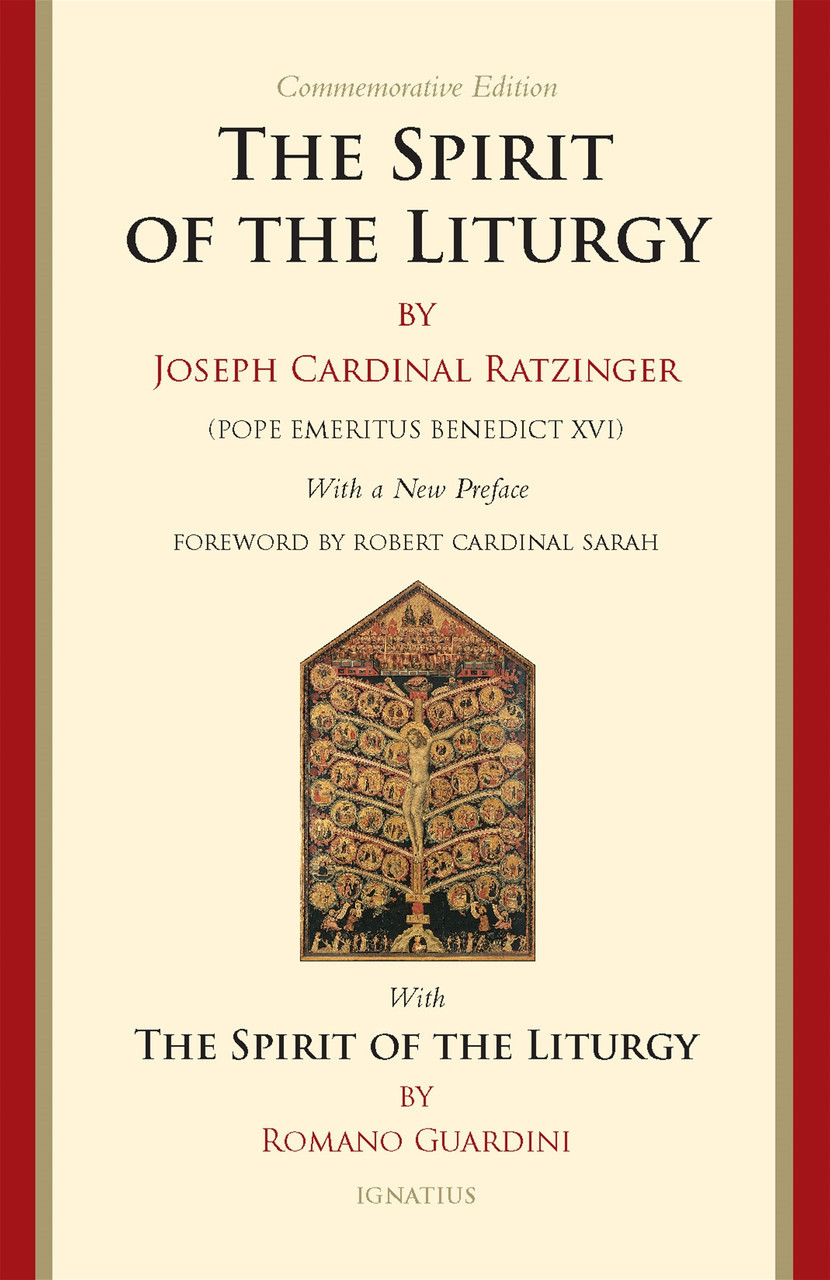‘The Spirit of the Liturgy’
Cardinal Ratzinger’s book addresses various liturgical controversies
Father Gregory Rothfuchs Comments Off on ‘The Spirit of the Liturgy’
As the Church in the United States progresses more deeply into the National Eucharistic Revival with its four invitations posed by the U.S. bishops, the quest to “reinvigorate worship” and engage in “robust faith formation” invites deacons in a particular way, as servants of the Sacred Mysteries, to understand the nature of the liturgy more deeply. While whole libraries have been filled with books and journals devoted to the Sacred Liturgy, the recent death of Pope Emeritus Benedict XVI spurs renewed notice of one of his classic works on liturgical theology, “The Spirit of the Liturgy” (Ignatius Press, $19.95), a book that some reviewers have placed on the short list of his most significant works.
The topic of Catholic liturgy inflames strong feelings and inevitably leads to sometimes immoderate intransigence of opinion. Recent surprises over restrictions imposed on the Tridentine Mass in the Latin Rite have caused not a few Catholics enamored with “the old Mass” to feel disenfranchised and to express their discontent publicly. Even more dramatically, the implementation of liturgical reforms in the Syro-Malabar rite in India has caused rioting, hunger strikes, the resignation of clergy and the direct intervention of the pope. What was the spark that ignited such upheaval? The directive to have the priest face East (ad orientem) during the Eucharistic prayer in the celebration of the Holy Qurbana.
When these various controversies are addressed from either the perspective of traditional or progressive adherents, the terms of the debate often arise out of the framework of ecclesiastical politics or fashion. Advocates on both sides can sometimes fall into the thoughtlessness of claiming either that everything new is good or everything new is bad. What is missed in all this vitriol, however, is answering fundamental questions about the liturgy itself.
What Is Liturgy?
“The Spirit of the Liturgy” begins with the essential questions, “What is the liturgy? What happens during the liturgy? What kind of reality do we encounter here?” (p.13). Then, a few chapters later the question is posed even more precisely, “How can man again connect the world with God? How is he supposed to make valid atonement?” (p. 35). With these words, Cardinal Ratzinger — the first edition of the book was released 27 years before his election to the papacy — opens a profound rumination on the origin, structure, purpose and divine character of the liturgy. “It is not a question of theories about God but of the right way to encounter him” (p. 160).
In setting up the question the way he does, we can see instantly that he is proceeding down a different path than those who base their arguments on sociological footing. “What is in harmony with the essence of the liturgy, and what detracts from it?” (p. 74). For many, the measuring line of “good liturgy” today is relevance and resonance, such as: Does this liturgy connect with everyone? Does it speak to people, especially the young? Is it memorable? Does it draw people in? These are secondary questions to Ratzinger. It is not that he dismisses such concerns, but he asserts that if the liturgy is not true to its nature and divine origin, it will not satisfy the deepest longings of the soul and, therefore, its “success” will be ephemeral. “Man himself cannot simply ‘make’ worship. If God does not reveal himself, man is clutching empty space” (p. 21).
Worship and Sacrifice
A concept, which weaves its way through the entire book, is an idea originating among ancient Jews under the influence of Greek culture at Alexandria and subsequently taken up by St. Paul (cf. Rom 12:1), and later by the Fathers of the Church: logikē latreia. This phrase has so many layers of meaning as to be an entire liturgical theology in two words. Ratzinger translates it as, “worship and sacrifice with spirit and mind” (p. 45). He draws out of this phrase a profound theology by connecting it with the idea of the Logos in the prologue of John’s Gospel. The Eternal Word, present in the cosmos from the beginning as the unifying rational principle of creation, then revealed in the Incarnation as true flesh and blood with us, unites himself ever after to those who approach him in the sacred mysteries. True worship is far more than human ritual; it is a participation in the Divine Word, a sharing in the life of Christ through divine action, which makes us participants in what we could never attain on our own. “It is man, conforming himself to logos and becoming logos through faith, who is the true sacrifice, the true glory of God in the world” (p. 46).
From this, it becomes clear that the liturgy is not a merely human action, the result of human creativity. The liturgy is the divine action into which humanity is incorporated so as to participate in the nature of the Logos, the Divine Word. “His self-giving is meant to become mine, so that I become contemporary with the Pasch of Christ, and assimilated unto God” (p. 58). Even more beautifully, Ratzinger sees this movement of identification as encompassing far more than the individual soul, as a cosmic event oriented toward eschatological completion. “We are incorporated into the great historical process by which the world moves toward the fulfillment of God being ‘all in all’” (p. 59). This means that in the liturgy the action of God is always primary; therefore, when human action becomes the focus of attention, something is amiss. “The real ‘action’ in the liturgy in which we are all supposed to participate is the action of God himself” (p. 173).
‘Looking Together at the Lord’
Of course, these lofty ideas are not left in celestial abstraction. Ratzinger spends a good deal of time applying these principles to various particular questions of the liturgy. His reflections on the direction the priest faces during Mass would be of great help to the Syro-Malabars, some of whom have reacted with outrage to the restoration of the ancient practice of facing East (ad orientem) during the Eucharistic prayer, as mandated by their synod and the pope. Ratzinger makes the point that the East, as the symbol of the Resurrection, emphasizes that the direction of the Eucharist can be none other than the Risen Christ. “Looking at the priest has no importance. What matters is looking together at the Lord” (p. 81).
Other elements of the liturgy are also brought into focus in a way that draws out scriptural roots that many lifelong Catholics probably have never noticed. His examination of liturgical music, the Sign of the Cross and liturgical posture reveal a deeper significance to even the smallest aspects of the sacred action. Of particular note is his detailed analysis of the posture of kneeling as a specifically biblical posture with no parallels in ancient pagan religions. “The man who learns to believe learns also to kneel” (p. 194).
Throughout this profound little book, Ratzinger offers his typical density of thought, showing how much greater the liturgy is than any merely human ritual of worship. “Where God’s will is done, there is heaven, there earth becomes heaven. Surrendering ourselves to the action of God, so that we in our turn may cooperate with him — that is what begins in the liturgy and is meant to unfold further beyond it” (p.176).
FATHER GREGORY ROTHFUCHS is the pastor of St. Joseph Church in Lockport, Illinois. He has an ardent interest in the beauty of the liturgy which was sparked by his dabbling in liturgical theology at the Pontifical Atheneum of Saint Anselm.
……………………………………………………………………………………………………………………………………………….
The Liturgy Moves Us to Be One in Holiness
“The liturgy is the summit toward which the activity of the Church is directed; at the same time it is the font from which all her power flows. For the aim and object of apostolic works is that all who are made sons of God by faith and baptism should come together to praise God in the midst of his Church, to take part in the sacrifice, and to eat the Lord’s supper.
“The liturgy in its turn moves the faithful, filled with ‘the paschal sacraments,’ to be ‘one in holiness’; it prays that ‘they may hold fast in their lives to what they have grasped by their faith’; the renewal in the Eucharist of the covenant between the Lord and man draws the faithful into the compelling love of Christ and sets them on fire. From the liturgy, therefore, and especially from the Eucharist, as from a font, grace is poured forth upon us; and the sanctification of men in Christ and the glorification of God, to which all other activities of the Church are directed as toward their end, is achieved in the most efficacious possible way.”
— Sacrosanctum Concilium, No. 10
…………………………………………………………………………………………………………………………………………………






